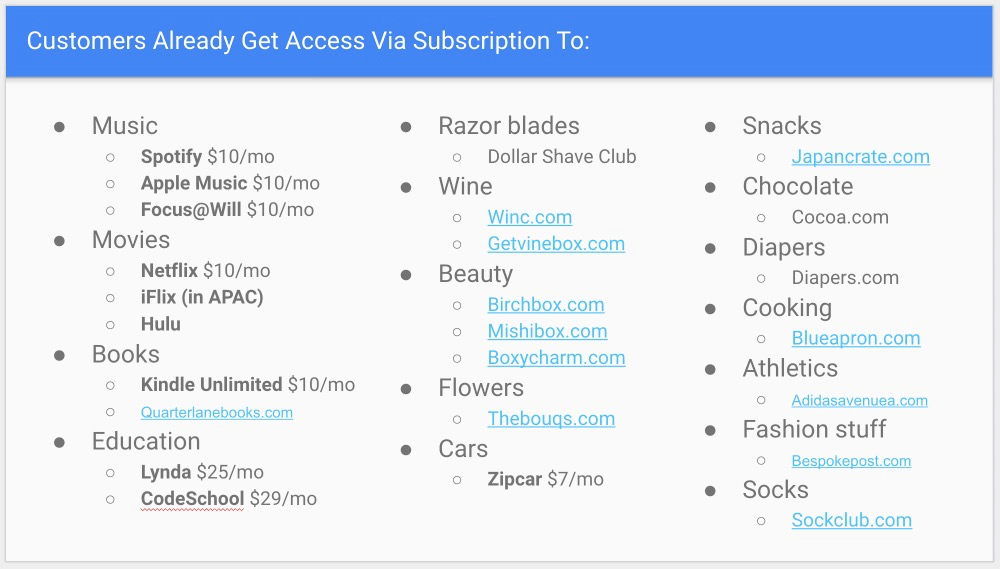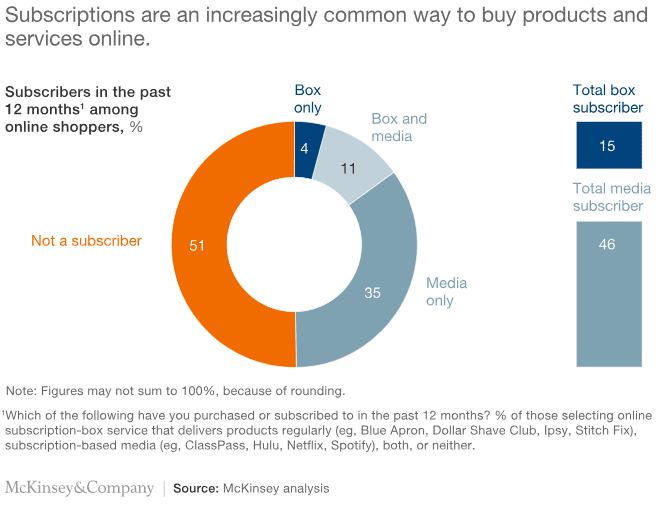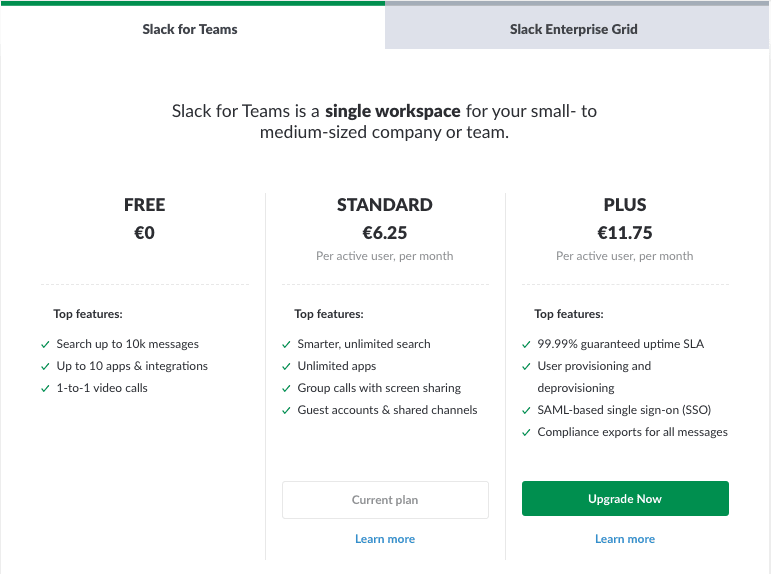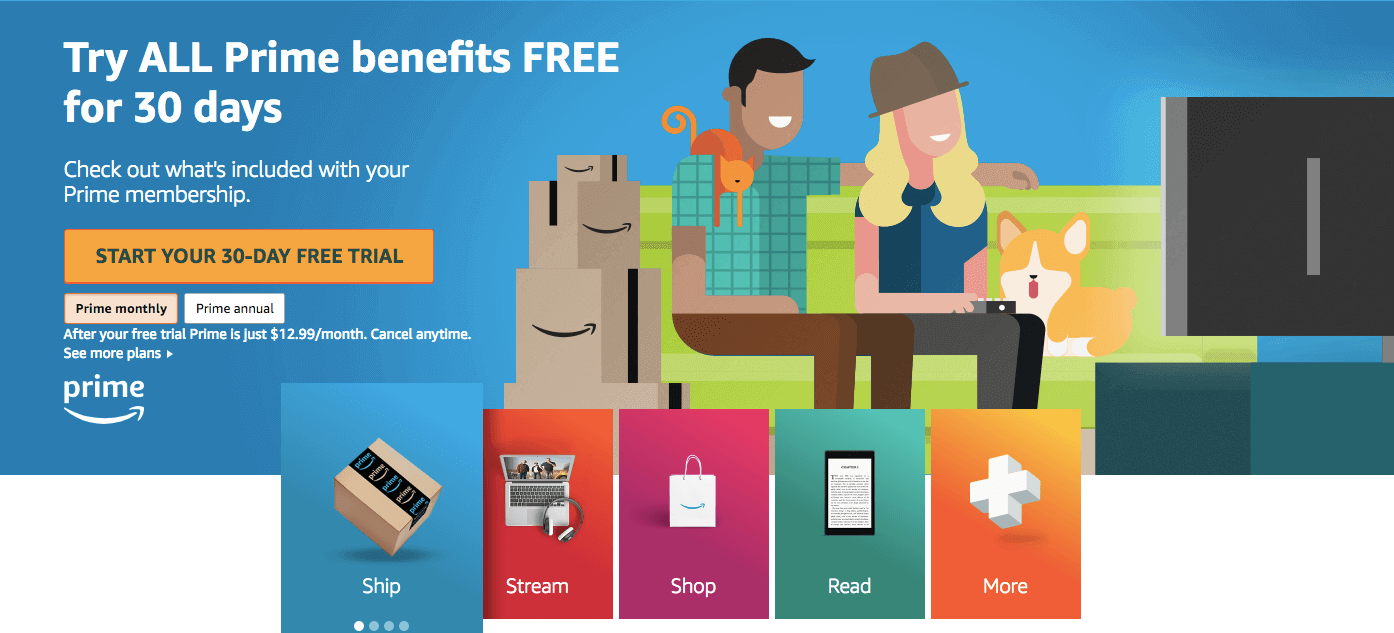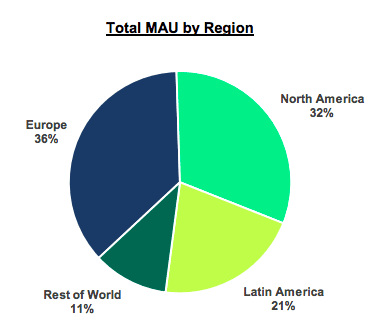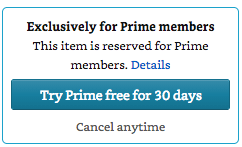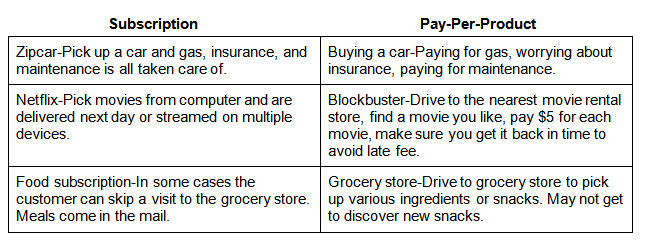| Not logged in : Login |
About: How To Scale Your Business With A Subscription Business Model Goto Sponge NotDistinct Permalink

With the subscription business model, customers or members pay a set amount each week, month or year, and in return, they get a service in exchange. Today the subscription business model has become the standard for many tech companies. From Netflix to Spotify and Amazon Prime, the subscription business model allows companies to build a more stable turnover. In fact, you can easily understand the power of the subscription business model compared to a traditional product or one-time service sale. Let's take two scenarios. In the first, you launch a product that sells at $200 to 100 people. In the end, you have $20,000. Let's take the case in which you sell a service for $100 to 100 people. In this case, you made $10,000. Yet, the coming month or year, you'll not start from zero but a predictable revenue. That is why many businesses are adopting the subscription business model. Also, today the way of consuming things, in general, has changed. We'll see in this article, why the subscription business model is taking over entire industries. We'll also evaluate if and when this is an effective business model. Many talks about the subscription business model as something new. Yet it's not. This is the way the traditional media industry has worked for centuries. The subscription business model is as old as the newspaper As reported via psprint.com: At first, newspapers were only available to wealthy Americans, those who were literate and could afford to pay for subscriptions in advance. The subscriptions typically cost what a general laborer would make in an entire week of work, so most could not afford them. That all changed in the 1830s, when advances in printing and papermaking made it possible to sell newspapers for one cent per copy.Increased literacy as well as technological advancementssuch as the telegraph – which made it possible to quickly share news over great distances – and the rotary press contributed to newspaper growth. The “Penny Press” made newspapers affordable to the entire public and spurred an explosion of newspaper publishing across the United States. Thus the subscription business model isn't new. However, what's new about it is where it is getting applied. For instance, since a few decades back it was hard to think of music as a service (see Spotify) or media that before was consumed at fixed time slots now it gets served at any time with streaming (see Netflix). Is it the end of ownership? Is it the end of ownership? As Tien Tzuo, chief executive officer and co-founder of Zuora pointed out: The signs are everywhere — ownership is on the outs. From Spotify’s IPO to Amazon Prime hitting a hundred million memberships to Lyft’s new monthly pass, more and more people are opting for fluid services rather than static products. In fact, our physical world seems to be rapidly diminishing all around us. Companies aren’t buying buildings, they’re renting from WeWork or Servorp. Teenagers aren’t saving up to buy cheap cars, they’re catching rides with their phones. Even the malls are disappearing. The world is switching from capex to opex. The reason for opting to usage rather than ownership can vary. Some of the major drivers of change are related to the fact that as technology allows us to track and connect people some services that wouldn't' have had since a few decades back now do. Also, as on-demand services have become available, the total cost of ownership has become too burdening. The total cost of ownership and why cars become expensive in the long run When you purchase a car, its initial cost is just one part of the expense. Real costs associated with the car will be the whole set of maintenance costs and operating costs to keep the car working. As pointed out by consumerreports.org "many brands have low ownership costs during year three. Keep in mind that some—including BMW and Mini—have free maintenance for the first few years, making them relatively affordable out of the gate. But costs can skyrocket when the warranty and free maintenance periods are over." If you own a car, you know what we're talking about. When you purchase a car you might have coverage for a few years, but the more the car gets older, the more expenses you'll have. At the point in which maintenance expenses skyrocket. The same issue applies to home ownership. If we take an estimate from caniretireyet.com you can see many of the hidden costs of homeownership: In short, in the example above for a house valued at around $100k, we have several costs on a monthly basis which amount at $834. Thus, if you could rent the same home for a lower price than renting might be the right choice. One thing is important to point out. In many cases, ownership vs. renting is not about financial considerations alone. In many instances, emotional reasons apply. At the same time companies like Airbnb are building their success more based on the home as a place to share and around experiences. Online vs. physical? That might be the wrong dichotomy As remarked on Zuora: Retailers are mistakenly seeing the issue as e-commerce versus brick and mortar, but that’s not the problem,” says Tien Tzuo, chief executive of enterprise-software firm Zuora. “Online, in-store, it shouldn’t matter, it should all be blended: Consumers can shop wherever they want–it’s the retailers that build one-on-one relationship customers that will win. Thus, it's not about the channel it's about the relationship. Tzuo remarked, "Amazon isn’t successful just because it’s an e-commerce site, but because it knows how to think like its customers.” In other words, what makes Amazon strategy effective it isn't the fact that it has online stores. Instead, it uses data to make the user experience as personalized as possible. When you go to an Amazon store, the way books are organized isn't random. Why subscription model might actually be easier for consumers Source: neilpatel.com What makes the subscription model so successful today it isn't only about ownership vs. usage. That is also about how things get consumed. In an ownership model, the interaction between the provider and the consumer is entirely different compared to a model where the provider needs to establish a relationship with the "member." Where a provider that sells a product won't need to know its customers. The subscription business model to be successful requires an ongoing relationship with continuous feedback from member to the service provider. This is also the reason why companies like Spotify and Netflix spend billions on producing TV Series and Music. In short, to avoid the members to churn from their accounts any time soon they need to keep providing great experiences on a regular basis. Also, as companies like Netflix gain a better and better understanding of their members (through the data fed to its algorithms), waiting for the next big hit coming from the Hollywood Studios might be too risky. Instead, with all that data, Netflix can produce series that its members will find more compelling and stick to their premium plan longer. That is also why as of the end of 2017, Netflix reported over $17 billion in streaming content obligations "primarily due to multi-year commitments associated with the continued expansion of our exclusive and original programming." Building and maintaining a relationship it's quite expensive. Let's dive a bit into the numbers of the subscription economy. The Subscription Economy Source: mckinsey.com According to McKinsey report, top five subscription business models include companies like Amazon Subscribe & Save, Dollar Shave Club, Ipsy, Blu Apron, and Birchbox: Amazon Subscribe & Save Dollar Shave Club Ipsy Blue Apron Birchbox As pointed out by McKinsey report: Both men and women, buying for themselves or for others, use many of the leaders, but women are more likely to subscribe to beauty and apparel services, including Stitch Fix (apparel), AdoreMe (lingerie), and ShoeDazzle (shoes). Men, by contrast, are much more likely to gravitate to razors (Harry’s is the third-most-popular service for men but the seventh overall), video-gaming gear and collectibles (Loot Crate), and meal-kit or food-delivery services (Home Chef and Instacart’s subscription delivery option, in addition to Blue Apron and HelloFresh). The interesting part of the Subscription Economy is that any kind of product can be transformed into an experience, thus a service that can become a subscription business model. In fact, in some cases, the subscription business model depends upon creating a surprise box. In other cases building up a subscription business model is really up to your creativity. Don't believe me? See the next example. Take a snack box mix it up and you get Gaze mini-snack subscription box Graze is a mini-snack subscription box that sends a customized selection of treats weekly, bi-weekly, or monthly. The process is simple: Create your account and tell them what you like Graze tailors your box and delivers it for free Once receive your snacks you can rate them so that Graze will learn your preferences One thing you might notice. This isn't a one-time relationship but a continuous process. A feedback loop, between Graze and its members. After a few iterations Graze will know the tastes of the members so well that with no effort at all Graze will be able to deliver the best experience ever. Three models of subscriptions Although subscription business models can have unlimited applications. They can be categorized into three main groups. Replenishment subscription In the Replenishment subscription model, consumers get an automated purchase process of commodity items. Think of razors or diapers that can be bought with one click. You might think that the Amazon Dash Button is about making a transaction frictionless (in fact it is). Yet this is only part of the story. Dash Buttons can be used by the "exclusive" Amazon Prime Members. Thus, this is just one of the many strategies Amazon is employing to get more subscribers. Also, all the data provided via those buttons will be a precious asset for Amazon in the long run! You get toilet paper effortlessly. Yet Amazon receives valuable data about you, anywhere at any time. Curation subscription Just like we saw in the Graze business model above. That is based on "curation." Graze does a great job in personalizing the experience from time to time, until it gets better over time: For a curation subscription to be sustainable, it has to surprise and delight with highly personalized experiences. Access subscription The Amazon Dash Button above can also be included in the access subscription. Here you pay a monthly fee to obtain lower prices or members-only perks. Getting the dash button is itself a "perk" exclusively granted to Amazon Prime customers. Another example might be Apple Music. Rather than buying a single song you can get a membership and listen to any: Other subscription business model examples Source: medium.com/the-graph/subscription-economy Netflix The Netflix business model is a powerful example of a subscription-based model. Indeed, Netflix has used its monthly fee to boost its recurring revenues. The subscription revenue model is also what allows Netflix to make substantial investments in content compared to traditional mass media, where each deal needs to be secured again: Related: How Does Netflix Make Money? Netflix Business Model Explained Spotify Spotify is another powerful example of a subscription business model. The company has been able to create a massive base of users worldwide in a relatively short period. Spotify benefits from classic two-sided network effects. When more users join the platform, the platform itself becomes more valuable for artists that decide to launch their music over the platform. And the more artists decide to feature their content exclusively on Spotify, the more the platform becomes valuable to more subscribers. Related: How Does Spotify Make Money? Spotify Business Model In A Nutshell Slack Amazon Prime Those companies financial success depends upon their ability to keep their members to churn. Beware of members churn Getting a fixed amount of money in the bank account each month is the dream of any company. Yet, having members stick might be the hardest task. Why do members churn? Hubspot mentions five main reasons: Lack of (or Zero) Engagement Poor Product-Market Fit Product Bugginess Difficult User Experience Lack of Proactive Support To make sure your subscription business model is sustainable in the long run you want to keep a careful eye on some key metrics. The key metrics to measure whether your subscription business is successful over time Running a successful subscription business model is about balancing things up. Just like having your revenues cover your expenses, in a subscription business model your customer acquisition costs have to be lower compared to the lifetime value for your customers. Thus, the following metrics are critical: Subscriber acquisition cost The subscriber acquisition cost comprises aggregate costs, such as marketing, sales commissions, installation for acquiring one subscriber. Monthly recurring revenue (MRR) This is the magic number many subscription-based startups need to look at to grow their business in the long run. This is the amount of fixed revenue retained every month. This metric is pretty simple to compute: multiply net users per month by the subscription fee. A growing MRR is critical for the healthy growth of your subscription business model. Churn rate This is computed by multiplying net users left per month by the subscription fee. Keeping the churn rate in check is critical. Monthly recurring costs (MRC) The monthly recurring costs are the cost incurred to earn the recurring monthly revenue. For instance, if you offer a software as a service, you will have server costs and support costs for those accounts. They do bring you money each month, but also costs. Lifetime value (LTV) The Lifetime Value is the total revenue earned per subscriber. Monthly active users (MAU) Another key metric, especially used by tech companies which survival depends upon the continuous interactions of its users with the platform is the monthly active users. Spotify is an example: Does a freemium work with the subscription business model? The freemium business model has become omniscient in the tech startup world. Thus, many associate it with the subscription business model. In reality, the freemium makes sense when the cost structure allows it. I suggest you dive into this article: https://fourweekmba.com/freemium-business-model/ What subscription models can you apply to your business? According to The Automatic Customer, there are seven models you can apply to your business. Membership website model All-you-can-eat content model Private club model Front-of-the-line model Consumables model Surprise box model Simplifier model Network model Peace-of-mind model Key takeaway The subscription business model has become by itself an economy. In fact, if you look more carefully and dive deeper you'll find examples of subscription business models anywhere. The subscription business model is the financial dream for many companies because you can create a constant stream of revenues each month from your business. However, maintaining that revenue stream is also quite costly. We saw how companies like Netflix and Spotify spend billions in content just to have their members stick. A subscription business model requires community building, continuous engagement and a feedback loop to keep personalizing the experience of the members. What to read next? What Is a Business Model? 30 Successful Types of Business Models You Need to Know What Is a Business Model Canvas? Business Model Canvas Explained Marketing vs. Sales: How to Use Sales Processes to Grow Your Business What Is Business Development? The Complete Guide To Business Development What is SEO Hacking? How to Steal Featured Snippets with These SEO Hacks
| Attributes | Values |
|---|---|
| type | |
| label |
|
| label |
|
| sameAs | |
| Relation | |
| author | |
| Description |
|
| depiction | |
| name |
|
| url | |
| http://www.w3.org/2007/ont/link#uri |
Alternative Linked Data Documents: PivotViewer | iSPARQL | ODE Content Formats:
![[cxml]](/fct/images/cxml_doc.png)
![[csv]](/fct/images/csv_doc.png) RDF
RDF
![[text]](/fct/images/ntriples_doc.png)
![[turtle]](/fct/images/n3turtle_doc.png)
![[ld+json]](/fct/images/jsonld_doc.png)
![[rdf+json]](/fct/images/json_doc.png)
![[rdf+xml]](/fct/images/xml_doc.png) ODATA
ODATA
![[atom+xml]](/fct/images/atom_doc.png)
![[odata+json]](/fct/images/json_doc.png) Microdata
Microdata
![[microdata+json]](/fct/images/json_doc.png)
![[html]](/fct/images/html_doc.png) About
About


![[RDF Data]](/fct/images/sw-rdf-blue.png)
OpenLink Virtuoso version 08.03.3330 as of Mar 11 2024, on Linux (x86_64-generic-linux-glibc25), Single-Server Edition (7 GB total memory, 6 GB memory in use)
Data on this page belongs to its respective rights holders.
Virtuoso Faceted Browser Copyright © 2009-2024 OpenLink Software

